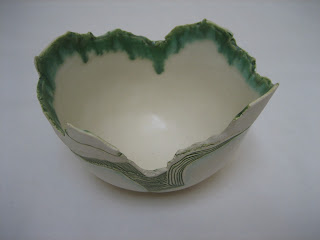Or How Many Cracked Bowls Does It Take To Learn To Let Go?
I’ve been working in clay for over 40 years. (Gasp! I just figured that out and can’t believe it myself!) After all these years, I still get nervous/anxious/excited/relieved when I finally have the work ready to be glaze fired and bring it to the kiln. It’s a weird bundle of floating anxieties, which begins as I’m glazing the pieces and doesn’t end until I get the very last fired piece out of the kiln.
If I haven’t mentioned this recently, it’s good to say again: The lesson you learn early on when working in clay is not just the parable about “letting go”. Rather, it’s the huge slap upside the head that inevitably happens just when you think you’ve got it all figured out. In clay, as in life, you are bound to learn sooner rather than later, you are NOT in control.
Once you’ve handed over your painstakingly, lovingly crafted pieces to the kiln gods, it’s over. You have relinquished your authority. You can hope that the firing will go well, the glazes will perform as expected, the results will be as imagined and planned but, really, you never know.
Yesterday, I delivered twenty pieces including the commissioned platters to be fired by my fine friends at the Potter’s Studio in Berkeley. In 2006, I moved into my Oakland studio and found out there wasn’t a 220 amp hook up nor an easy solution to venting my electric kiln through the roof. The only alternative was to find a place which would take outside work to be fired. Voilá! The Potter’s Studio has been my preferred choice for outsourcing the firing ever since.
At first, I was very leery about giving up this important part of the clay making process as I’ve been doing my own firing since 1977 when I bought my first electric kiln. When we sold our Berkeley property in 2006 where I had a wonderful studio, I still used that small kiln, a raku kiln and a new larger digital Skutt kiln. I sold the first two and moved the Skutt into the new studio.
The Skutt has now morphed into a largest most expensive display unit ever made.
 |
| Skutt kiln as display unit |
I have to admit, both Bob and Jasmine, two of the Potter’s Studio technicians, are so versed in kilns, firings, etc., I’ve come to not just rely on them, but to actually feel a sense of relief knowing that they’re professionals who take special care when stacking and firing the work. While I’ve had a few disappointing outcomes, they were not the result of technical misfirings, but rather my own slipups.
Here’s one that happened to a couple of porcelain pieces. It took Bob to point out that glazing just the inside of the piece was creating stress on the thin unglazed outside porcelain wall as the glaze began to melt. The expansion of the glaze as it matured on the inside made it crack.
I have since begun to use a clear matte glaze on the outside of the porcelain pieces to prevent this from happening. It rarely happens to the stoneware pieces because they have more grog or clay strength to hold the walls together, thankfully.
 |
| cracked porcelain pinch pot with unglazed exterior |
 |
| interior of the cracked porcelain pinch pot with matte glaze |
I have since begun to use a clear matte glaze on the outside of the porcelain pieces to prevent this from happening. It rarely happens to the stoneware pieces because they have more grog or clay strength to hold the walls together, thankfully.
 |
| porcelain pinch pot with clear matte glaze exterior |
 |
| interior of the porcelain pinch pot with matte glaze |
So now I wait with baited breath to get the call that the pieces are ready to be picked up. Until then, I’ll be sending up little prayers to the kiln gods, hoping they’ll do right by the work. After all, it’s now in their hands. OK, theirs and the folks at the Potter’s Studio.
Lesson learned once again. We are not in control.